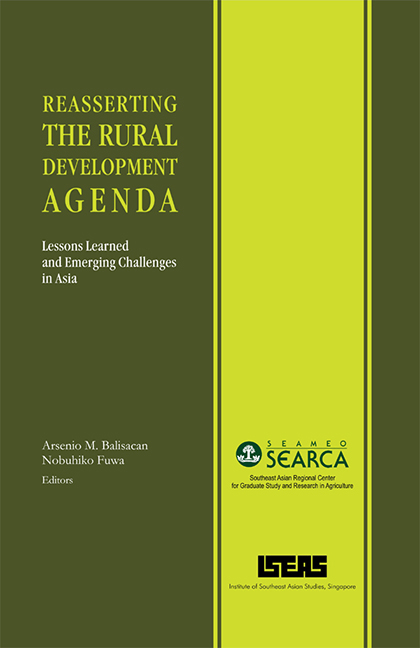Book contents
- Frontmatter
- Contents
- Tables
- Figures
- Preface
- Contributors
- 1 Challenges and Policy Options for Agricultural Development – Overview and Synthesis
- 2 The Economics of Agricultural Development: What Have We Learned?
- 3 The Role of Social Structures and Norms in Agricultural Development: Africa and East Asian Communities Compared
- 4 Food Security in a Globalised Setting
- 5 Poverty and Vulnerability
- 6 Asian Agricultural Development: From the Green Revolution to the Gene Revolution
- 7 Dryland Agriculture in Asia: Ideas, Paradigms, and Policies
- 8 Establishing Efficient Use of Water Resources in Asia
- 9 Improving the Delivery of Extension Services to Rural People: New Perspectives
- 10 Land Tenure and Forest Resource Management in Asia
- 11 Globalisation and the Poverty-Environment Link in Asian Agriculture
- 12 The Supermarket Revolution with Asian Characteristics
- Index
8 - Establishing Efficient Use of Water Resources in Asia
Published online by Cambridge University Press: 21 October 2015
- Frontmatter
- Contents
- Tables
- Figures
- Preface
- Contributors
- 1 Challenges and Policy Options for Agricultural Development – Overview and Synthesis
- 2 The Economics of Agricultural Development: What Have We Learned?
- 3 The Role of Social Structures and Norms in Agricultural Development: Africa and East Asian Communities Compared
- 4 Food Security in a Globalised Setting
- 5 Poverty and Vulnerability
- 6 Asian Agricultural Development: From the Green Revolution to the Gene Revolution
- 7 Dryland Agriculture in Asia: Ideas, Paradigms, and Policies
- 8 Establishing Efficient Use of Water Resources in Asia
- 9 Improving the Delivery of Extension Services to Rural People: New Perspectives
- 10 Land Tenure and Forest Resource Management in Asia
- 11 Globalisation and the Poverty-Environment Link in Asian Agriculture
- 12 The Supermarket Revolution with Asian Characteristics
- Index
Summary
Introduction
Crops are grown in Asia under a wide range of climatic and water resource environments including management with and without irrigation in highand low-rainfall areas. For example, rainfed rice environments (including rainfed lowlands, uplands, and submergence-prone and saline environments) account for 45 per cent of the total rice area but produce only about a quarter of the total rice output (MacLean et al. 2002). However, what has marked the growth in agricultural production, particularly in the last four decades, has been the use of modern high-yielding cereal grain varieties and chemical fertilizers on rapidly expanding irrigated acreage. Irrigation has been the sine qua non of the so-called Green Revolution. While the massive investments have brought benefits, they have also been a source of many problems. Irrigated agriculture in Asia uses approximately 80 per cent of the water resources, of which almost two-thirds is used to irrigate cereal grains. The growing scarcity of water and the rapid growth of Asia's economies have created an urgent need to manage water resources for irrigation and for other uses. Accordingly, ways are being sought to establish a more efficient use of water resources and to manage water for the protection of the environment.
In this chapter we briefly chart the development of irrigated agriculture over the past half-century. We also identify current issues in the management of water resources. We then discuss the paths to improve water management and water productivity. Finally we focus on the institutional and policy changes and the incentives needed to establish an efficient use of water resources.
Asia n Water Resource Management – A Retrospective Look
Until recently there has been very little concern for the management of water resources in agriculture. Most crops were grown under rainfed conditions with supplemental irrigation. Agencies that dealt with irrigation and with other sectors – municipal, industrial, hydropower – rarely communicated with each other, and concern for the protection of the environment was minimal. Irrigation systems (for example, the well-known warabandi system in northwest India and Pakistan) were typically “administered” rather than “managed”. Irrigation has developed in four distinct but overlapping phases, namely: a) community systems, b) river diversion systems, c) large storage dams, and d) groundwater extraction. While all four systems are important, public investment in large storage dams and private investment in groundwater extraction were largely responsible for a doubling of irrigated areas over the past four decades.
- Type
- Chapter
- Information
- Reasserting the Rural Development AgendaLessons Learned and Emerging Challenges in Asia, pp. 227 - 266Publisher: ISEAS–Yusof Ishak InstitutePrint publication year: 2007



